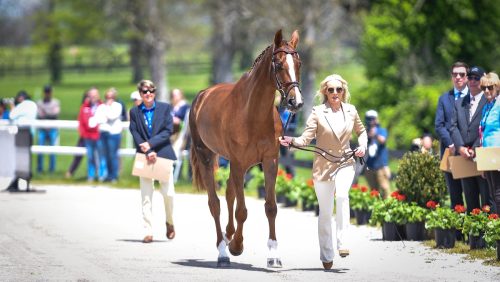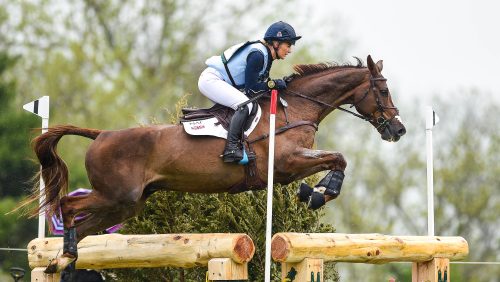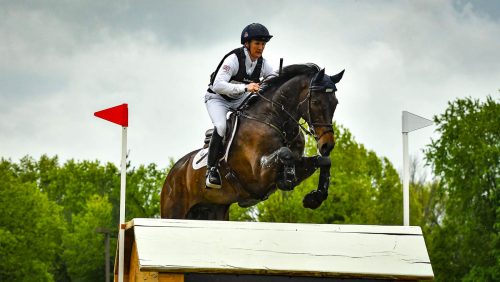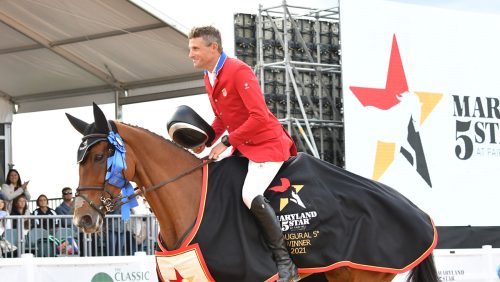When Darren Chiacchia fell at the 2002 Bromont CCI** (Que.), he knew he couldn’t linger in bed for long. Despite cracking one side of his hip and breaking off a piece of the other side of his hip (as well as tearing muscles, cracking ribs and bruising), he wanted to be riding in the World Equestrian Games three months later.
“The goal of the WEG gave me a single-minded focus to get back in action,” he said. “I was convinced that was going to happen. The doctors didn’t agree, but it happened.”
In Chiacchia’s case, he thinks his extensive experience in the sport helped him move on quickly, without any lingering nerves after his fall. “It’s not like you can shake it off, get back on, and ride another one [when you have a serious injury]. When you’re laid up, that’s your last thing that happened. For an amateur, when you have a fall and don’t know what you could have done differently or why, it’s hard to process, and it can make them intimidated.”
For Chiacchia, the most frustrating part of his fall was being physically sub par for months afterward. “I had residual problems for a long time–my leg was numb for months,” he said. Still, he said, he “just sort of did it.”
But not before giving the accident some thought. “You always learn from it,” he said. “If you didn’t, you’re stupid, and I’ve never met a good rider who’s not intelligent. You’ve got to be honest–did I ride too fast or was it too difficult for my horse? Sometimes it’s just a misstep.”
Chiacchia tried to get back in the saddle a week after his fall. “That was not a good idea, so I waited another week,” he said. Within five weeks of his fall, he was competing again, which secured him a spot on the WEG squad with RG Renegade.
“From a young age, I haven’t lived in the past,” he said. “If there’s a lesson to learn, I make a mental note and go forward.”
He sees a big advantage, though, for riders who have more than one horse. “I’ve had competitions where I’ve fallen from the first one and had to ride more, and that’s a huge benefit. You can’t spend two weeks stewing over what happened,” he said. “It’s great when you can jump on the next one and just go do it.”
Stephen Bradley also kept his goal–the 1992 Olympics–foremost in his mind while recovering from a fall at the 1992 Rolex Kentucky CCI. Bradley had fractured a rib and suffered a compression fracture in his back after falling with Hy Flying Brent at Kentucky. But he rode Sassy Reason–and won–at the Checkmate CCI*** (Canada) six weeks later, securing his spot on the Olympic team.
“I didn’t actually get back on until I got up to Canada,” he said. “It was very nerve-wracking thinking of going to a three-star without getting on [for six weeks], but I had all kinds of history with him. I wasn’t concerned because it was Sassy. If I’d had to ride the same horse [I fell with] again, I don’t know if I could have done it, but [the fall] really didn’t play on my mind.”
Bradley didn’t let himself dwell on the accident. “I knew it was a hard fall, and I knew why it happened,” he said. “I made a point not to think about it because I couldn’t remember it well anyway. I didn’t look at pictures or videos, and that was very helpful. Any time I started to think about it, I made myself stop.”
Discovering Your Mortality
Karen O’Connor recalled that a fall at the 1987 Burghley CCI**** (England), where she perforated her kidney, was her first taste of her own mortality. “It’s a big moment of reflection on your riding and what you can do to improve,” she said. “You analyze it, then analyze that, then analyze it some more, and watch it on film. You end up thinking about how to prevent that from happening again.”
O’Connor spent a month in the hospital in England and didn’t return to a horse’s back for almost six months. “When your body gets injured–not your arms and legs and collarbone, but your organs–those kinds of falls have a big effect on you,” she said. “It really took a year for me to ride aggressively and courageously again.”
O’Connor doesn’t see any reason to rush things if a rider feels anxious following a fall. “You get more careful and have more time faults, but that’s a state you have to allow to happen, however long it takes,” she said. “If that’s where you are at that moment to be a safe cross-country rider, then that’s where you are. It’s an individual thing, and everyone has to make their own decision.”
But there can be positive repercussions of accidents too. “The responsibility you feel makes you a better rider,” said O’Connor. “You make it your mission to find out your weaknesses because you don’t want it to happen again.”
For Buck Davidson, a serious fall at the Menfelt Horse Trials (Md.) in 2000 made him realize he had to pay more attention to his horses’ balance and details on cross-country.
ADVERTISEMENT
“Before the fall I was young and dumb, a little too brave for my own good,” he said. “I’d been more worried about winning than surviving. I became more conscious of doing it the right way, rather than looking at my watch.”
Other injuries–such as a broken ankle (which didn’t stop him from riding in a steeplechase race) and a broken collarbone–hadn’t fazed Davidson, but displacing and fracturing his femur forced him to take some down time.
“That was the only time where I couldn’t suck it up and keep going,” he said with a laugh. “It gave me time to think.”
Since his fall happened in plain view, Davidson said he was repeatedly told how scary the accident looked. “I went over what I would have done differently, and I knew what went wrong,” he said.
Like O’Connor, Davidson started back slowly when he returned to competition. “I don’t know that I consciously thought about it, but when I first came back, I probably did take an extra pull where I would have kicked before,” he said. “I won my first event back, but I was way more nervous than I would usually be for a preliminary event.”
And in his next event, Davidson fell on an intermediate course–and he believes that was probably the best thing that could have happened to him. “You realize every fall isn’t going to really hurt you,” he said. “The biggest part of healing was knowing I hit the ground and was fine.”
Davidson thought his physical efforts to stay in condition while injured helped him mentally. “As soon as I could get into a pool and get myself back going, I was in there,” he said. “You have to keep everything else from falling apart, get the rest of your muscles in shape. When I was physically ready to go, I was mentally ready too.”
But that doesn’t mean he immediately considered himself to be riding at the same level as before, partly because the leg still hurt, and he was compensating, carrying himself off center to protect it. “Any time you break a bone, it probably takes you a year to get back to where you feel good,” he said. “Eighteen months later, when I got the rod out [of the femur], then I was fully back.”
And Davidson said there’s one other lesson he took away from the accident, when Class Touch tried to leave out a stride on a three-stride, downhill combination. The horse started to leave the ground, then put his feet down again and hit the huge log with his chest: “I never thought he was going to fall. I believed he was too good. I dropped [the reins] and [leaned] back, so he ended up falling on top of me. When all is lost, know when to get away.”
Helping Students
Just as Davidson used his fall to re-examine his own cross-country technique, he also told student Laine Ashker to take the same lesson from her fall at this April’s Rolex Kentucky CCI, where she broke her neck. “She told me, ‘This is the first time I’ve been nervous to go cross-country,’ and I said, ‘Laine, that’s the best thing I’ve heard. Nothing bothered you before–now you have a better sense of what can happen.’
“She had a great ride at Groton House [(Mass.) in June], and she’s back. We all need to learn; it’s just that sometimes learning hurts a little. But [we find out] the little things matter more than we appreciated they did.”
Of course, riders who didn’t lean toward the bold side before a bad fall might be even more affected by a serious accident. “If I felt a fall had damaged my confidence, I would seek [professional sports psychologist] help in dealing with that immediately, because horses sense that lack of confidence,” said Chiacchia. “Horses feed off your confidence, and when you’re worried, they’re worried.”
If Bradley has a student battling their nerves, he makes sure to set up exercises that he knows they’ll complete successfully. “You present [the exercises] in a building-block way and build their confidence that way,” he said. “That’s one of the most important concepts I learned when I had my fall–you need to work with someone you trust implicitly. You need to trust their judgement and opinion.”
In her clinics, O’Connor stresses the importance of knowing how to fall. “I ask riders to re-identify with why children are given tumbling lessons, to learn to fall without injury, to take a fall and absorb the impact through your body. If you can remember why you took tumbling and what it was like to tuck and roll [that will help].”
Questioning Yourself
While she never once doubted that she wanted to compete again, O’Connor did lose confidence in her abilities after her fall at Burghley. “I did think, was I good enough to continue? Was I a bad rider who’d been given good horses? My confidence issue was, was I good enough to be given the opportunity to do it again?”
Bradley’s confidence was at its lowest–and his nerves at their highest–not after his fall, but in the late 1990s, when he’d gone several years without a horse at the upper levels.
ADVERTISEMENT
“When I started stepping horses back into that level, that’s when I had to work through nerves,” he said. “I hadn’t been jumping big or going at speed, so I came out a little quiet and slow.”
Bradley credited his trainer, Bruce Davidson, with helping him work through that period. “We never even had to talk about it–he knew exactly what I was going through,” said Bradley. “He kicked me in the butt and said, ‘Here’s what you’ve got to do and go do it.’ “
O’Connor recalled two specific periods of her career where she suffered a series of falls–one where she was working on better balance on cross-country, and one where she was trying to be more competitive and faster on cross-country.
“It’s generally because you’re working on something new, or you need to be working on something [that you have falls],” she said. “Falls aren’t necessarily random–in many cases it’s a pattern in your riding. The sport wasn’t designed to have people or horses fall.”
For Davidson, the danger remains in the back of his mind–but he doesn’t worry about it. “It’s way more dangerous for me to drive from New Jersey to Philadelphia than to get on a horse and go cross-country,” he said. “When it’s your time, it’s your time. I mean, you can get hurt getting out of the shower.
You are going to get hurt, but you can’t worry about life all the time.”
Bradley definitely sees age as one of the factors that affects riders’ ability to put a bad fall behind them.
“When you’re younger, you think nothing can hurt you, and you’re certainly not going to die,” he said with a laugh. “As you get older, you’re more practical. You realize bad things happen to nice people. And when you think about things more, you start to worry about what could happen. I also see that with older ladies who have children. But we all have to work through certain mental things. As you get older, you can’t help but have that affect you.”
The biggest effect of age on Bradley has been in the selection of his mounts. “In the last few years I’ve decided I really don’t want to ride horses who are not good athletes and jumpers. You have to be smart about picking the horses you ride, especially when you’re coming back from a fall,” he said. “Adult amateurs [who are nervous] especially need a safe horse, one who’ll stop before he falls down.”
When Bradley and Stonehenge fell at the Foxhall CCI*** (Ga.) this spring, Bradley rebounded to get back on his second horse, Brandenburg’s Joshua, and ride to the victory.
“I was nervous when I got on Joshua; it does shake you up [to have just fallen]. But after three or four fences, I realized Josh was up and pumped for the job, and he’s one of the best jumpers I’ve ever ridden,” he said. “In that case, it was my horse who helped me get my confidence back and breathe again.”
Coaches, spouses and friends can help as much as a good horse, but ultimately, said O’Connor, you have to do it yourself: “It’s your own inner strength you have to draw on, to want to fix it.”
Taking Responsibility
For most riders, experiencing a serious injury to their horse can be at least as mentally damaging as an injury to themselves.
“When you pilot that horse, you’re ultimately responsible,” said Karen O’Connor, who has had the misfortune of losing three horses on course during her nearly 40 years of competition.
“If you’re the last person holding the reins, that’s a big deal. It has a big impact on you emotionally. A piece of you goes with that horse, for sure,” she added.
Losing a horse can also cause a rider to reflect about what went wrong on an even deeper level. “It gives you an increased respect for what horses can do and what we ask them to do, for what they’re thinking and why they react the way they do,” O’Connor said. “You don’t want to repeat that ever again. [The times I have lost horses] have been very, very big lessons in my life and very hard lessons. You think what this is all about and why horses are so generous.”
For O’Connor, those lessons have contributed to the person she is. “A lot of the top people [in horse sports] have a lot of virtues of integrity and honesty with yourself. The horse allows you to explore your own honesty and responsibility. As you’re more successful as a horse person, the responsibility within you grows,” she said.














